.jpg)
Vauxhall Vivaro-e Life Review
.jpg)
Introduction
We know what you’re thinking. “Why on earth would I want to buy a van?”
But bear with us.
Yes, it's a van - sort of. But Vauxhall is one of several manufacturers who have realised there’s a market it can tap into without going to the trouble of designing a whole new motor.
Select's rating score* - 3.8 / 5
At a Glance
The recipe is pretty straightforward: you pull out the all-wooden interior in the back, cut some holes in the side of it, add some glass windows, bolt a few seats in place, fit more car-like aesthetics inside and voila! It’s now a people carrier.
As a result, the Vivaro is repurposed from a builder's workhorse to a parent-mobile. It's now suitable enough to take the whole family out, including the kids – and their mates.
You might still think this vehicle sounds like a crazy idea, but you’d be surprised by just how many manufacturers are now doing this. Of course, Mercedes has been doing it for years with its V-Class, which is based on its Vito van – and Merc, too, has launched an all-electric version of it, called the EQV.
And, like the EQV, there’s no diesel rattle in the Vivaro here. As the ‘e’ in the name suggests, this is all-electric, as well.
It’s had a promising start, as the Vivaro-e van has already won awards.
The Life, the brand name for the people carrier version, looks more attractive than the van. It has body-coloured bumpers on the top-of-the-range model and subtle detailing, making the vehicle look more desirable than your average builder's runabout.
The model is still unmistakably van-shaped, but the styling – which includes an angled lower grille – adds some personality to the front end.
Down the side, there’s a sliding door, creases towards the bottom and a side skirt. Meanwhile, the shape of the side windows, which are more rounded towards the rear, add more character than if they were squared-off.
There’s not much to write home about around the back, although the sizeable rear windscreen can be opened outwards to a 90-degree angle.
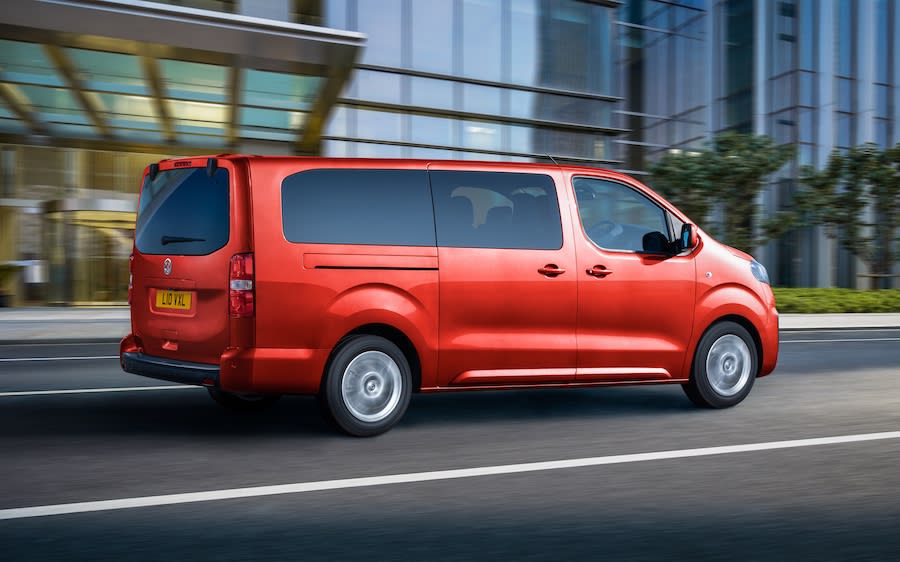
Key Features
There are two trims available in the Vivaro-e Life.
The entry-level is called the Combi trim, but it’s reasonably threadbare and doesn't come with many features. You get 16-inch steel wheels, air conditioning, cruise control, a trip computer, electric parking brake, electric door mirrors and windows. Oh, you also get a stability system with traction control, hill start assist, a digital radio with Bluetooth and four speakers - but that’s about it.
Surprisingly, Vauxhall is still happy to sell a vehicle without an infotainment system – because you don’t get one here. And given this car will be used on airport runs and motorways, the lack of such a system means there’s no SatNav.
In a motor so big, you bizarrely don't even get parking sensors.
If you ever wanted to compare a vehicle with watered-down skimmed milk, this is it. The good news, though, is that there is a full-fat version.
The flagship Elite model upgrades the wheels to 17-inch bi-colour alloys and adds electric sliding side doors, heated front seats, a memory function on the driver’s seat and roof-mounted rear heater controls. You also get a Multimedia Navi Pro infotainment system with a seven-inch colour touchscreen and SatNav, a 3.5-inch information display, a heads-up display, ten speakers, leather seats and dual-zone climate control. Parking sensors feature, as well, along with a rear-view camera, rear-side window blinds and a panoramic glass roof.
That’s an awful lot of kit on the Elite that’s not available on the Combi, and we’re surprised there isn’t at least one mid-range ‘semi-skimmed’ trim to bridge the gap.
While the diesel-powered Vivaro Life is available in standard or long-wheelbase form, the electric versions are only available in the latter. But a more extended wheelbase means more space, so you won't find us complaining about that.
The electric motor which powers the Vivaro-e Life produces 136PS.
Range & Batteries
You get a 50kWh lithium-ion battery, which achieves a claimed range of 143 miles.
You'll struggle to match this figure in the real world, though - especially with a full load of passengers and luggage. This is particularly the case if you're using the Vivaro-e Life on motorways, where we expect it to be driven regularly.
The electric range is significantly lower than the Mercedes EQV, which has a much larger 90kWh battery. But then the EQV is in a different pricing league, with even the entry-level model costing almost half as much again on top of the range-topping Vivaro-e Life Elite.
It’s worth noting that the Citroen e-SpaceTourer, Peugeot e-Traveller and the Toyota Proace Verso Electric have identical figures because, essentially, they're all the same vehicle, just with different badges.
Performance & Drive
This isn’t a vehicle built for performance.
Low-speed driving, for example, is acceptable. As with most electric vehicles, throttle response is instantaneous, with a quick burst of power sufficient to get you up to a slow driving speed.
But it isn’t enough to get you properly moving. And once you need to speed up, this is where the Vivaro-e Life comes unstuck.
This is partly due to it being somewhat underpowered. But also because it's insanely hefty. It weighs 2830kg, making it one of the heaviest vehicles we've ever tested.
As a result, 0-62mph takes 13.1-seconds. The four-cylinder diesel versions will do it in 10.4-seconds (2.0-litre 180PS) and 14.6-seconds (1.5-litre 120PS).
The all-electric Mercedes-Benz EQV, by comparison, manages it in 12.1-seconds. But, if you want to see what the combustion engine can do, the 2.0-litre diesel V-Class, on which it’s based, can do it in 7.8-seconds. So, this shows the sluggishness is more due to the powertrains rather than the vehicle itself.
What’s worse is that we’re testing it with just a couple of us in the vehicle, so it’s likely to be even slower with eight or nine people aboard.
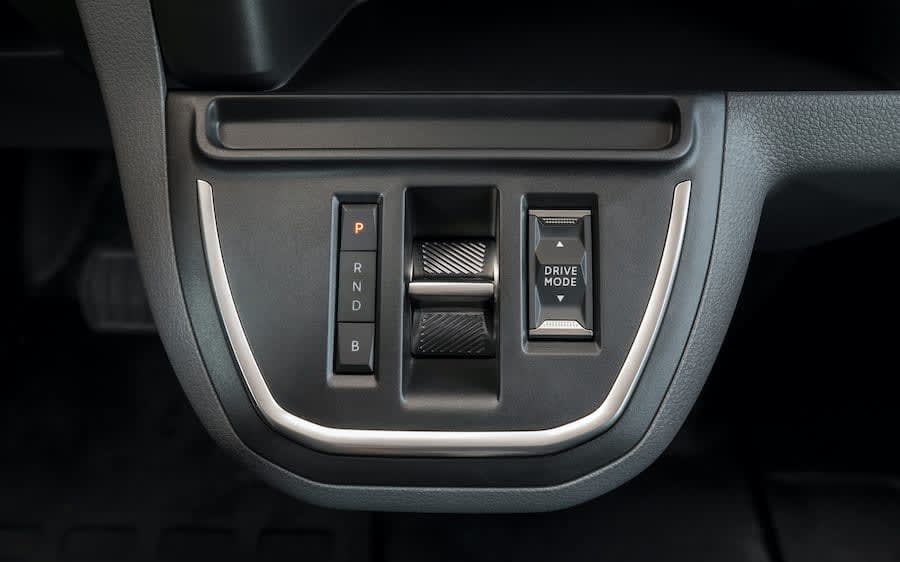
Switching to ‘Eco’ turns the acceleration down a notch – something you probably don’t want any less of – while the air conditioning, which is one of the most power-hungry features in a vehicle, is reduced, along with non-essential electrical systems to maximise battery life.
There’s also ‘Power’ mode, which prioritises performance by doing the opposite of Eco mode. But you probably won’t use it, as you won’t want to be losing any more range. Finally, 'Normal' mode is the halfway house between the two.
Paddles behind the steering wheel adjust the regenerative braking. When used, you’ll decelerate far more quickly when taking your foot off the accelerator but gain some extra charge in the process.
Given there's no engine noise, Vauxhall has done a decent job of reducing wind noise, while the tyres don't produce that much in the way of road roar. The suspension has a typically van-like rattle to it, though.
Regarding handling, the Vivaro-e Life doesn’t feel that well planted on the road, producing a bouncy ride, although we suspect this will be calmed by having more passengers on board. In addition, it leans a lot in the corners, which is to be expected, but little seems to have been done to attempt to minimise it.
The steering feels pretty unresponsive and heavier than it should. What's more, it requires an excessive steering lock to turn sharp corners. We reckon it will be exhausting if you need to drive this around tight bends and roundabouts all day.
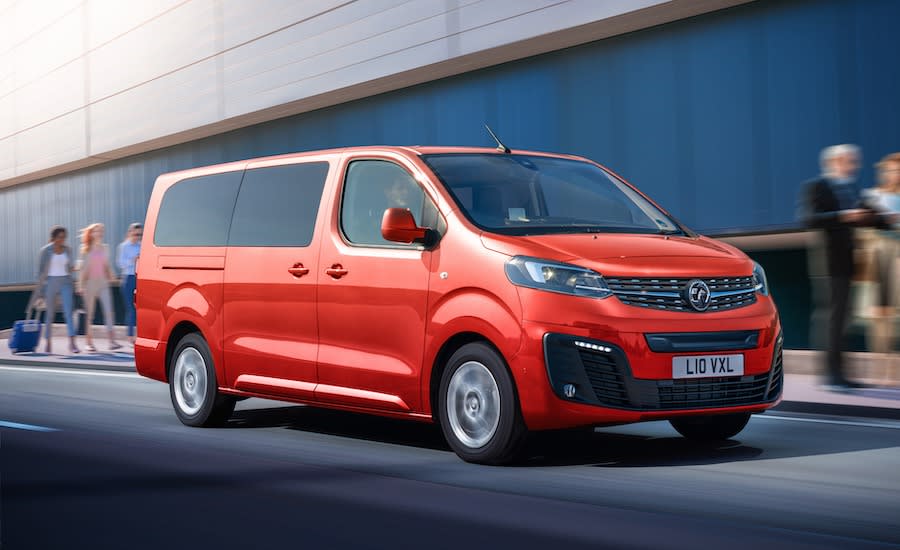
Charging
The Vivaro-e Life supports rapid charging up to 100kW, meaning that you can get from empty to an 80% charge in around half an hour.
A dedicated wall box at home will get you from zero to 100% in around seven and a half hours.
Running Costs & Emissions
The good news is that environmentally conscious drivers will be thankful for the zero CO2 emissions.
But, in all honesty, you're going to be constantly charging. Something like the Vivaro-e Life will be used as a private hire vehicle, doing airport taxi runs and long-distance motorway miles. So even if it does achieve the claimed range of 143-miles, you won’t have many days when you’re not plugging it in.
Because of that, the cost of charging up depends greatly on your circumstances. If you need to charge it quickly while out and about, you’ll probably get fleeced more for the privilege.
Best get on a comparison site to ensure you're on the cheapest tariff for your home power consumption.
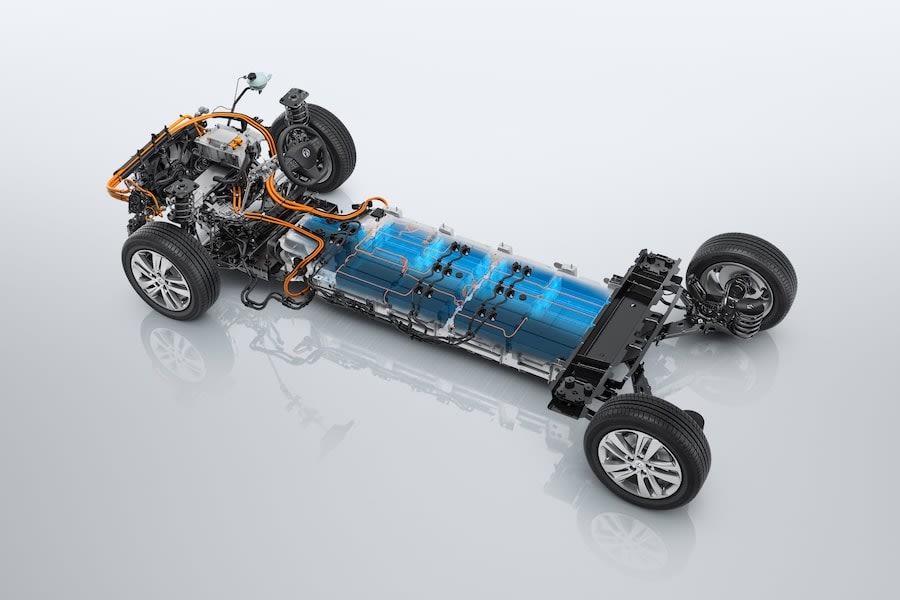
Interior & Technology
Although an attempt has been made to give the Vivaro-e Life a less van-like interior, the reality is it’s half-hearted, with minimal expenditure on Vauxhall’s part and, at best, it barely bridges the gap between van and car.
It’s still pleasant to look at, but luxuriousness is very limited. We had hoped Vauxhall would cover the cheap hard plastics with a softer outer material, but this hasn't been done.
The seven-inch touchscreen on the infotainment system lags quite a bit, and it's far behind other systems on the market today. It’s not exactly difficult to use, though, and some of it can be controlled using the rotary knob on the centre console and the buttons on the steering wheel. Meanwhile, shortcut buttons on each side of the screen also help to find your way about.
The seats are comfortable, with a commanding driving position, while the view is good out of the front.
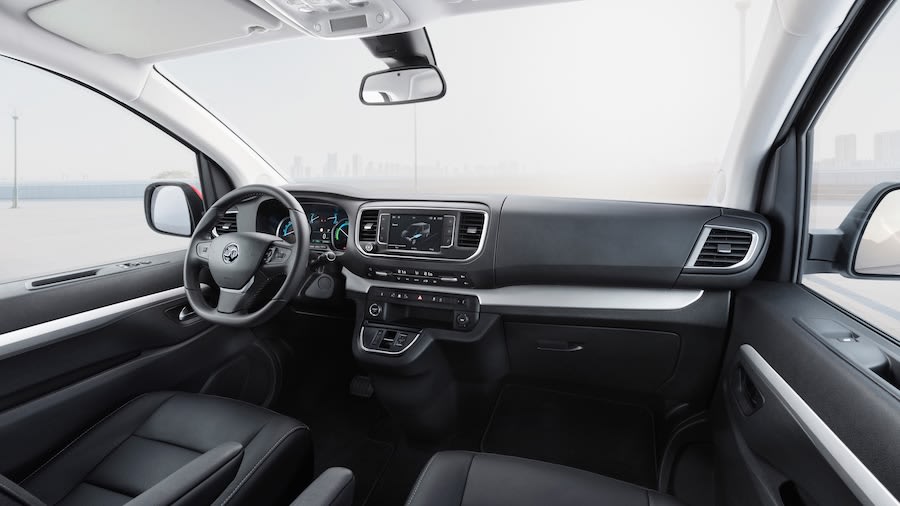
Practicality & Boot Space
You’ll have to trust us when we say there’s loads of space, because actual boot capacity figures aren’t generally published for vehicles like this.
The simple reason is that there’s so much flexibility in terms of seating positions that the boot space can be as much or as little as you want, depending on the configuration you choose.
You do, after all, quite literally have the capacity of a van if you so choose. So, unless you’re trying to relocate a library, you won’t struggle for room.
The seats can face backwards, as well, so you could have two rows facing one another.
The electric sliding doors on the side make getting in and out straightforward, while headroom isn’t an issue, even in the Elite trim, which features a lower roofline thanks to the glass roof.
The front seats are electric, too, while there’s a centre console in the second row of seats if you select the seven-seater version.
That said, the eight or nine-seater versions are likely to be more popular. There isn’t much of a need to lease this vehicle if you only need seven.
What's curious, then, is that the Combi trim, which is too basic to be attractive to most motorists, accommodates nine people, but the Elite grade with all the extra kit only accommodates up to eight.
So, if you want a decent amount of equipment but need a vehicle for nine, you can't.
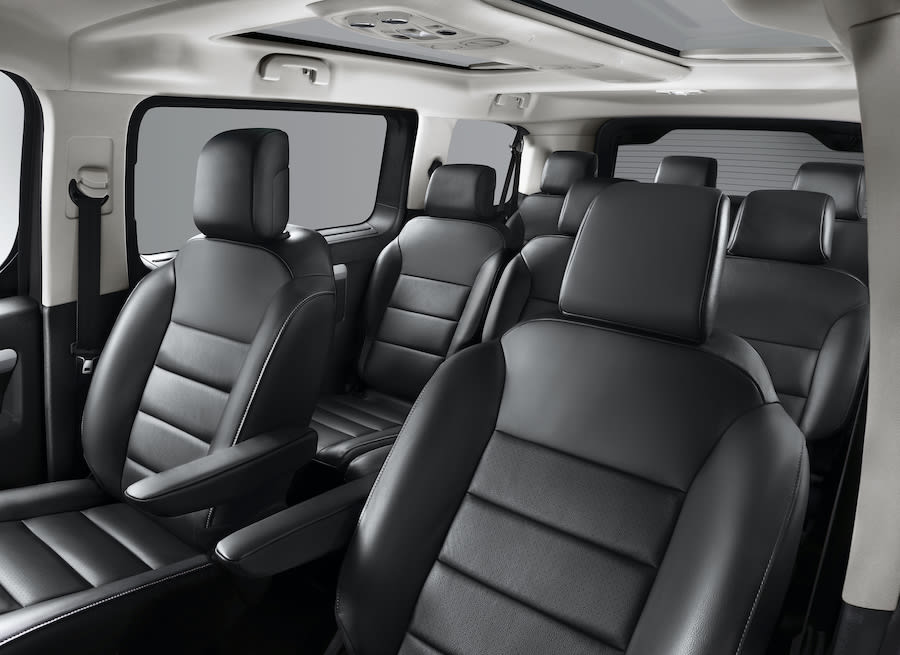
Safety
The Vivaro-e Life hasn’t been crash-tested by Euro NCAP yet.
However, the combustion-engined Citroen SpaceTourer, Peugeot Traveller and the Toyota Proace Verso, virtually identical to the diesel-powered Vivaro Life, have been tested. They all earned a five-star rating, scoring 87% for adult occupants, 91% for children, 64% for pedestrians and 78% for safety assists.
It's unclear how much difference the electric versions of these vehicles will make to the score, but this at least provides a decent ball-park figure. However, it's worth noting that Euro NCAP changed its criteria and made its tests more stringent in 2020 to better reflect advances in safety technology in recent years.
That means a five-star rating in 2015 doesn’t necessarily mean it would score the same if assessed today. So, if you’re comparing it with new vehicles launched this year, the comparison could be misleading.
All Vivaro-e Lifes include cruise control with speed limiter, airbags, electronic stability programme with traction control, anti-lock brakes, a tyre pressure monitoring system, hill-start assist and daytime running lights.
You also get an automatic anti-dazzle rear-view mirror, side blind-spot alert, and front and rear parking distance sensors on the Elite trim. A lane departure system, speed sign recognition, driver drowsiness system, forward collision alert with automatic emergency braking and pedestrian detection are included, too.
The Elite trim also upgrades the cruise control to semi-adaptive, while you get ten airbags, rather than the six in the Combi trim.
Options
There is no actual options list for the Vivaro-e Life.
This is incredibly frustrating, as it means the only way to get any of the kit that nearly every single human being would want is to opt for the Elite trim. This then limits you to eight rather than nine passengers, as we mentioned earlier.
If, for example, you don't mind it coming with no equipment and are happy with the Combi version but want to add the infotainment system, you can’t.
You might think it's no big deal because it surely doesn't cost all that much to upgrade to the next trim up, right?
Well… we haven’t yet mentioned that the price difference between the two trims, if you were to buy rather than lease, is… erm… £16,970. Wowsers.
Solid white paint is included as standard on all models but, if you want metallic, you’ll have to fork out an additional amount to pick from black, dark grey or light grey.
Rival Cars
Even though they’re the same, it’s worth mentioning the Citroen e-SpaceTourer, the Peugeot e-Traveller and the Toyota Proace Verso electric.
Besides a bit of brand-specific styling, they may be all equal, but some are more equal than others.
Citroen, for example, offers the electric version in three different grades, which may act as a happier medium for the gaping void left by Vauxhall in its limited menu of all-or-nothing trims.
Volkswagen has also revealed its electric van-turned-people carrier, the Multivan, which replaces the outgoing Caravelle.
Ford’s Tourneo Custom is available in hybrid form, while, if money is no object, the all-electric Mercedes EQV is also worth looking at.
Suppose you don't need the extra seats? In that case, there are any number of seven-seater SUVs available which have a far superior driving experience, such as the Kia Sorento plug-in hybrid.
Verdict & Next Steps
The Vivaro-e Life is cheap from some angles, and expensive from others.
Indeed, outside of its Citroen, Peugeot and Toyota sister models, you’ll struggle to find a more practical vehicle for less money.
But its two contrasting trim options, which go from one extreme to the other, really limit your choice. The gulf between the two makes the entry-level version seem unattractive, and the top-of-the-range version seems ludicrously overpriced. On the other hand, the Citroen is marginally cheaper and offers more flexibility in terms of spec.
For a full load of passengers, the Vivaro-e Life is underpowered and lacks range compared with the Mercedes EQV. But then the Merc costs a considerable amount more.
The range will be a problem, though, if you're frequently making long motorway journeys. When conditions are at their worst, you might struggle to make it beyond 100 miles, which completely defeats the purpose of a vehicle like this.
On the other hand, it has personality, it’s spacious and suitable for low-speed driving, while it’s a great way to get about in comfort.
We simply can't see why you'd choose one over a seven-seater SUV unless you need the eighth (or ninth) seat, though.
Where to next?
View latest Vauxhall Vivaro-e Life leasing deals - from just £302.80 per month inc VAT**
Looking for a great leasing deal? Check out our incredible range of car lease deals
New Large MPV? Read our latest Car Reviews and find the right model for you
Want to know more about leasing? Take a look at our comprehensive Leasing Guides
Interested in everything motoring? Why not catch up on all the latest Car Leasing News.
**Score based on Select’s unique meta score analysis, taking into account the UK’s top five leading independent car website reviews of the Vauxhall Vivaro-e Life
**Correct as of 22/10/2021. Based on 9 months initial payment, 5,000 miles over a 36 month lease. Initial payment equivalent to 9 monthly payments or £2725.20 Ts and Cs apply. Credit is subject to status.


















